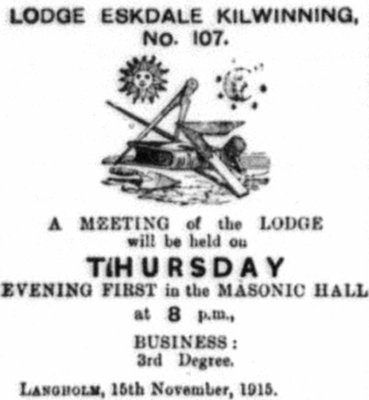Freemasonry can be traced back to the late 1300s, derived from stonemasons’ guilds (associations of craftsmen). Its organisational units came to be known as ‘lodges’, with governing bodies described as ‘Grand Lodges’.

There are different views on the etymology and connotations of the term ‘freemason’ (as distinguished from ‘mason’), with possible origins including working with ‘freestone’, belonging to a higher rank of stonemason, and/or being free from coercion.
The Grand Lodge of Antient Free and Accepted Masons of Scotland was founded in Edinburgh in 1736. It incorporated Scottish lodges by order of their date of foundation, including Kilwinning (in Ayrshire) as “No. 2”.
Kilwinning rejected this, claiming that it was Scotland’s oldest lodge. It split from the Edinburgh organisation and declared itself to be a Grand Lodge, ‘The Mother Lodge of Scotland’ with the number 0. It created numerous subsidiary lodges, including Eskdale Kilwinning No. 107, founded in 1767.

In modern freemasonry, aspects of stonemasonry have evolved from being practical to being allegorical. For example, the ‘three degrees’ used as qualifications in various allegorical traditions are typically based on the former practical levels of stonemasonry: apprentice, journeyman and master mason.
The installation of officials to Eskdale’s lodge on 2nd December 1915 gives an indication of a typical lodge’s structure and the extent to which prominent local townsfolk were involved:
| Office | Role | Individual |
|---|---|---|
| Right Worshipful Master (‘RWM’) | Senior official | Thomas Easton, provost, grain merchant |
| Past Master | Former RWM | Rev John Seaton |
| Past Master | Former RWM | Major Edward Bell, councillor, woollen manufacturer |
| Past Master | Former RWM | William Elton, solicitor |
| Past Master | Former RWM | Thomas Moses, tweed manufacturer |
| Past Master | Former RWM | Thomas Welburn, Inland Revenue officer; also belongs to Lodge Hubli, Bombay, India |
| Past Master | Former RWM | James Petrie, baker |
| Secretary | Administration | Thomas Moses, past RWM |
| Treasurer | Accounts | Robert Laidlaw, shoemaker |
| Substitute Master | Supervises if RWM/Senior Warden/Junior Warden are absent | William Allen, hotelkeeper, Commercial Hotel |
| Senior Warden | Senior RWM deputy | John Hawkins, warehouseman |
| Junior Warden | Junior RWM deputy | Edward Armstrong, warehouseman |
| Chaplain | Non-denominational prayers | Rev John Seaton |
| Senior Deacon | Senior mentor, organisational intermediary | Thomas Lightbody, tailor |
| Junior Deacon | Junior mentor, organisational intermediary | Alex Montgomery, councillor, hairdresser |
| Inner Guard | Validating meeting attendees, inside building | John Gill, painter |
| Tyler (Outer Guard) | Validating meeting attendees, outside building | Joe Anderson, watchmaker |
| Organist | Musical accompaniment | Cephas Brown, professional musician |
Below are two prizewinning Langholm masonic bowling teams. Note the ceremonial aprons.

The tournament below was the Dumfriesshire masonic championship in 1920. John Ewart was Common Riding cornet in 1903 and Langholm provost in 1940-1948.
